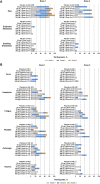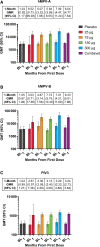Safety and Immunogenicity of an mRNA-Based Human Metapneumovirus and Parainfluenza Virus Type 3 Combined Vaccine in Healthy Adults
- PMID: 35794943
- PMCID: PMC9251669
- DOI: 10.1093/ofid/ofac206
Safety and Immunogenicity of an mRNA-Based Human Metapneumovirus and Parainfluenza Virus Type 3 Combined Vaccine in Healthy Adults
Abstract
Background: Human metapneumovirus (hMPV) and parainfluenza virus type 3 (PIV3) cause respiratory tract illness in children and the elderly. No licensed vaccines are available.
Methods: In this phase 1, randomized, dose-ranging, first-in-human study, the safety, reactogenicity, and humoral immunogenicity of an investigational mRNA-based hMPV and PIV3 combination vaccine, mRNA-1653, were evaluated in healthy adults aged 18-49 years. Sentinel participants (n = 20) received 2 doses of mRNA-1653 (25, 75, 150, or 300 μg) in the dose escalation phase, and participants (n = 104) received 2 doses of mRNA-1653 (75, 150, or 300 μg) or placebo in the dose selection phase; injections were 28 days apart.
Results: The most common solicited reactogenicity events were injection site pain, headache, fatigue, and myalgia, the majority of which were grade 1 or 2. A single mRNA-1653 dose increased neutralization titers against hMPV and PIV3 1 month after vaccination compared with baseline. No notable increases in neutralizing antibody titers were observed with escalating dose levels after mRNA-1653, although no statistical inferences were made; a second mRNA-1653 dose had little observable impact on antibody titers. Neutralizing titers through 1 year remained above baseline for hMPV and returned to baseline for PIV3.
Conclusions: mRNA-1653 was well tolerated, with an acceptable safety profile and increased hMPV and PIV3 neutralization titers in healthy adults.
Keywords: adult; human metapneumovirus; human parainfluenza virus; mRNA vaccine; parainfluenza virus type 3; safety and immunogenicity.
© The Author(s) 2022. Published by Oxford University Press on behalf of Infectious Diseases Society of America.
Figures



References
-
- Centers for Disease Control and Prevention . Human metapneumovirus (HMPV) clinical features. Updated 5 September 2019. Available at: https://www.cdc.gov/surveillance/nrevss/hmpv/clinical.html. Accessed 21 April 2021.
LinkOut - more resources
Full Text Sources
Other Literature Sources

